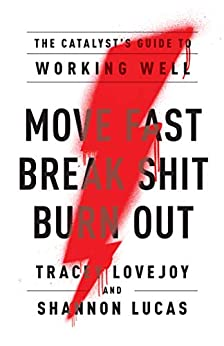Catalyst Leaders: 5 Telltale Signs | Part 2/2

By Gumball Associate, Tracey Lovejoy

To read the first part, please go here
Tracey Lovejoy is an Associate Certified Coach through the International Coach Federation, an accredited facilitator of The Five Behaviors of a Cohesive Team, and a Certified Everything DiSC Trainer and Partner. She has worked with clients in a variety of large organizations such as Amazon, Steelcase, Microsoft, Intel, and Vodafone, as well as supporting executives in small businesses and CEOs of startups. The core values she brings to her engagements are awareness, courageous action, and empathy.
In 2020, she published the book MOVE FAST. BREAK SHIT. BURN OUT. - a personal operations manual that helps Catalysts move fast without losing people, break shit with intentionality and lessen the intensity of the burnout cycle that most Catalysts experience. This post shares the five attributes that are common to a Catalyst - the signs that you are dealing with a Catalyst, or that you yourself are a Catalyst.
In the 2nd part, she tells you the remaining two telltale signs of a catalyst, how others describe them and how you can find out if you are a catalyst yourself.

4. Drive for Action That TRANSFORMS
Once a Catalyst has picked the visions that are worth driving toward they MUST take action. It is painful to not take action. And at the center of their drive is changing the world for the better. This drive comes across like a lifetime purpose to make the world around them better.
“I make things happen! If I go into a job or project I want to lead it and make things happen. I want to make it a success. I see the moving parts to make it happen. I see the goal and the way to make it get there.”
“Can you transform situations? Are you having a transformative role in how your daughter sees the world, how your department approaches research, how you do analysis? As a Catalyst it is kind of in your DNA – you have this drive to do it! To think about how something can grow, be exciting, innovative.”
This drive for action is a key differentiator between visionaries and Catalysts.
5. Learning and Experimentation Mindset
The final common attribute of Catalysts is how they engage with the world around them when they are taking action that allows for constant forward movement. Like scientists or designers they have a learning and experimentation mindset. This process is called many different things, such as the design thinking process, action learning or action research. And Catalysts are naturals.
With each new action they take, they monitor the results, learn and then iterate to make their next step even better. This process allows for constant action and allows for a reframe of failure. If you see your actions as ‘right’ or ‘wrong’, then the right action leads to success and the wrong action leads to failure. If, as a Catalyst, you view your actions as experiments then even if something doesn’t end up as you expected it to, it is just information – valuable information that guides how your next step should be redirected.
Unexpected outcomes or “failures” become a challenge, not an endpoint. This mindset creates tremendous resiliency and makes the Catalysts among us appear buoyant in the face of difficulty.
This way of being can be difficult for those around them because even when things come together well, a Catalyst doesn’t (or can’t) stop seeing possibility and optimizing for improved results. The pace of iteration, innovation and change can drive the people around them crazy.
“Game-changing or catalyzing with integrity means being clear on the long-term picture that you are willing to fail and experiment to bring to fruition… I don’t give up.”
“I’ve learned how important it is to have a learning mindset and never become complacent we know it all. So as a Catalyst I like to teach others to have a learning mindset. Without that, success just looks different. "
How Others Describe Catalysts
If you aren’t sure if you are a Catalyst consider how others might describe you.
There is a knowing that emerges for Catalysts as they build puzzles from the swirl of information around them. All those interviewed talked of not having to figure everything out to be ready to move forward. They just need to know enough to trust the leap is the right one. And to them, the leap doesn’t feel risky. This leads to Catalysts being described as risk-takers or intuitive.
When they’ve processed information and are ready for action, taking what looks like a bold step to an outsider doesn’t feel that risky to the Catalyst herself.
“When I am powerfully leading from the front I trust intuition versus trying to get it perfect and have all the answers and know what I’m doing.”
“I’m comfortable operating in the fog - with 40% to 70% of the information. With a strong intuition (gut feeling).”
Others can also assume Catalysts are comfortable with ambiguity. Catalysts know that to get to transformation they have to move through territories that are unknown. And while some Catalysts embrace ambiguity, it can also drive Catalysts insane. So it may not be that they like or welcome ambiguity. However, they may have gotten comfortable with ambiguity, or with knowing ambiguity is inevitable. It can still be very trying for them. It is just part of what MUST be to fulfill their innate drive. They know the feeling of the end state they are moving toward – they have seen it, felt it. So they will more comfortably lean into what is necessary to get there.
“Other people can be uncomfortable working with me if they are doing work without knowing where they are going. I don’t know where I am going either and for me, that is the beauty of it.”
“There is a danger with Catalysts not clearly sharing the full vision. The Catalyst might know, or might have enough of a sense, but they might not be good at sharing it so others might feel it is chaotic or murky. So people that are not good with ambiguity can be annoyed with Catalysts.”

Questions You Can Ask Yourself
If you are suspecting that you might be a Catalyst here are some questions that might help:
- Do I feel driven to do things to make the world around me better?
- Do I frequently piece together information quickly and see a path to action?
- Do I sometimes overwhelm people around me with all the ideas I have?
- Do I sometimes overwhelm myself with all the ideas I have?
- Do I often challenge the status quo or get referred to as disruptive?
- When tackling a challenge, do I try different approaches and figure out which is most effective as I go?
- Does the term Catalyst just feel like it fits?
If you answered ‘yes’ to every question, you are a Catalyst.
We Need Our Catalysts
The pace of change has accelerated in our world. We are in the VUCA (volatile, uncertain, complex, and ambiguous) world. Now, more than ever, we need people ready to lean comfortably into change. We need people that can see the changing world around them and quickly come up with ideas to improve and build. We need VUCA ready leaders. We need Catalysts.
If you are a Catalyst ready to embrace your catalytic nature, be sure to check out our book - it will unlock you!
And if you are a leader ready to identify and leverage your Catalysts - reach out to learn more.

MOVE FAST. BREAK SHIT. BURN OUT. One of Entrepreneur Magazine's "9 Must-Read Books to Prepare Entrepreneurs for 2021"

